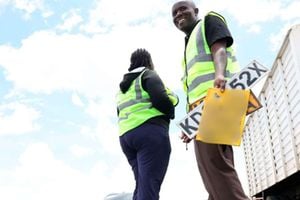Why gender violence is a threat to economic development

A GBV victim. The justice process needs to be expedited to reduce the inconvenience and emotional costs faced by survivors.
What you need to know:
- The most recent study on the cost of GBV was conducted by the sexual and gender-based violence team of Kenyatta University’s Women’s Economic Empowerment Hub, sponsored by the Bill and Melinda Gates Foundation.
- It covered the non-state Life Bloom Services International in Naivasha and the Gender-Based Violence Recovery Centre at Makueni County Referral Hospital.
During debate on the Protection Against Domestic Violence Bill (now an Act of Parliament) on August 19, 2014, then Nyeri Woman Representative Priscilla Nyokabi stated: “We are aware of women who have been unable to go to work [and] … men who have been unable to go to the farm because of domestic violence … We cannot continue to have people in our hospitals whose only sickness is domestic violence.”
Her point was that gender-based violence (GBV) is a cost to the economy, a pertinent local, national and global issue.
The first comprehensive study on the subject in Kenya was published by the National Gender and Equality Commission in 2016.
It established that the country lost between 7.8 per cent and 10 per cent of its gross domestic product to GBV.
The cost of emergency services to GBV survivors across the country at selected service delivery centres for five years was Sh10,798,520,644.
This excluded costs borne directly by survivors, families and children, as well as those arising from withdrawal from work during and after abuse.
The most recent study on the cost of GBV was conducted by the sexual and gender-based violence team of Kenyatta University’s Women’s Economic Empowerment Hub, sponsored by the Bill and Melinda Gates Foundation.
It covered the non-state Life Bloom Services International in Naivasha and the Gender-Based Violence Recovery Centre at Makueni County Referral Hospital.
Published by Elsevier Espana, S.L.U recently as “Estimating the economic impact of gender-based violence on women survivors: A comparative study of support program interventions in Makueni and Naivasha, Kenya”, the study categorises GBV costs as direct and indirect.
The former covers payments for services related to health, counselling, legal representation, replacement of lost property and transport.
The latter consists of days off domestic work and formal employment, and lost school days for children.
The average direct medical cost incurred by every woman survivor was Sh7,344 in Makueni and Sh5,069 in Naivasha.
Transport costs accumulated to Sh3,635 per survivor in Makueni and Sh1,389 in Naivasha per month.
Legal costs amounted to an average of Sh6,286 per woman in Makueni and Sh2,583 in Naivasha.
In addition, survivors who fled their homes for safety each incurred Sh5,000 in Makueni and Sh5,692 in Naivasha per month for accommodation.
Money spent every month on counselling by each survivor ranged from Sh3,000 in Naivasha to Sh3,921 in Makueni.
Costs related to children missing and having to change schools amounted to Sh33,965 per woman in Makueni and Sh49,402 in Naivasha.
To estimate indirect costs, the study considered lost working days for survivors and absence from school for children.
The former amounted to Sh4,669 per survivor in Makueni and Sh8,616 in Naivasha. Costs on children missing school came to Sh147,433 in Makueni and Sh70,211 in Naivasha.
Estimates of the value of domestic work lost amounted to Sh8,100 per month per survivor in Makueni and Sh8,700 in Naivasha.
Total indirect costs were Sh1,594,775 in Makueni and Sh1,160,928 in Naivasha.
In many instances, the perpetrators, primarily intimate partners, confiscated or destroyed the survivors’ property.
Such assets ranged from homes to personal items such as cell phones and jewellery.
This constituted physical and sentimental loss. The affected women estimated such losses at an average of Sh17,000 in both sites.
In total, the direct costs incurred by survivors in Makueni were Sh8,516,508 and Sh5,193,030 in Naivasha, excluding expenses related to children.
The figures could be higher if severe injuries, disability, emotional trauma, behaviour changes, social dysfunctions and death were factored in.
As the study shows, assigning monetary value to losses incurred from GBV demonstrates what the country could save if the vice were eradicated, hence the urgency to do so.
The study recommends that more GBV recovery centres should be established to make services accessible and reduce the financial burden on survivors.
Perpetrators should be held accountable using the existing legal framework, including the Victim Protection Act, which mandates financial compensation of survivors by perpetrators.
The justice process also needs to be expedited to reduce the inconvenience and emotional costs faced by survivors.
There should also be monitoring of survivors for long-term effects, augmented with necessary economic support towards full recovery.
And more detailed scientific research should be conducted to capture the multi-dimensional nature of the costs of GBV, a complex affair given the varying computational methods used, variables included by different researchers and difficulty in quantifying components such as psychological damage.
This calls for partnership between academic institutions and the Kenya National Bureau of Statistics towards a comprehensive formula on the same.
The writer is an international gender and development consultant and scholar ([email protected]).





